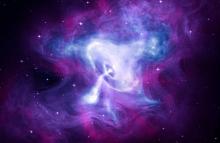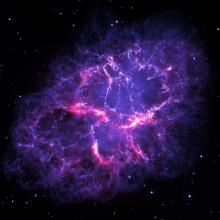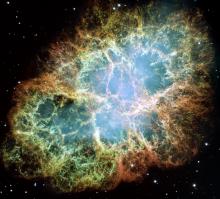Listen to today's episode of StarDate on the web the same day it airs in high-quality streaming audio without any extra ads or announcements. Choose a $8 one-month pass, or listen every day for a year for just $30.
You are here
Crab Pulsar
Almost a millennium ago, a star announced its death in dramatic fashion — as a brilliant new star in the constellation Taurus. It was bright enough to see in daylight for weeks.
The star left behind an expanding cloud of debris that resembles the outline of a crab. It’s near the tip of one of the bull’s horns, which is high in the sky this evening. But you need a good telescope to see it.
The remnant is known as M1, the Crab Nebula. It was born when a heavy star exploded as a supernova. The star’s outer layers have spread out to form a cloud that’s several light-years across.
At the center of the cloud is the star’s crushed core — a neutron star. It’s several times the mass of the Sun, but only as wide as a small city.
The explosion that created the nebula also caused the neutron star to spin more than 30 times a second — a rate of about four million miles per hour at its equator.
The explosion also created a powerful magnetic field. As the star spins, the field causes it to beam energy into space. Radio telescopes detect the beam as on-off “pulses” of radio waves, so the neutron star is also known as a pulsar.
The pulsar produces a “wind” of charged particles that sculpts the interior of the surrounding cloud. And it causes the pulsar to slow down — but only by about ten millionths of a second per year. So the Crab Pulsar will keep spinning for a long time to come.
More about pulsars tomorrow.
Script by Damond Benningfield





